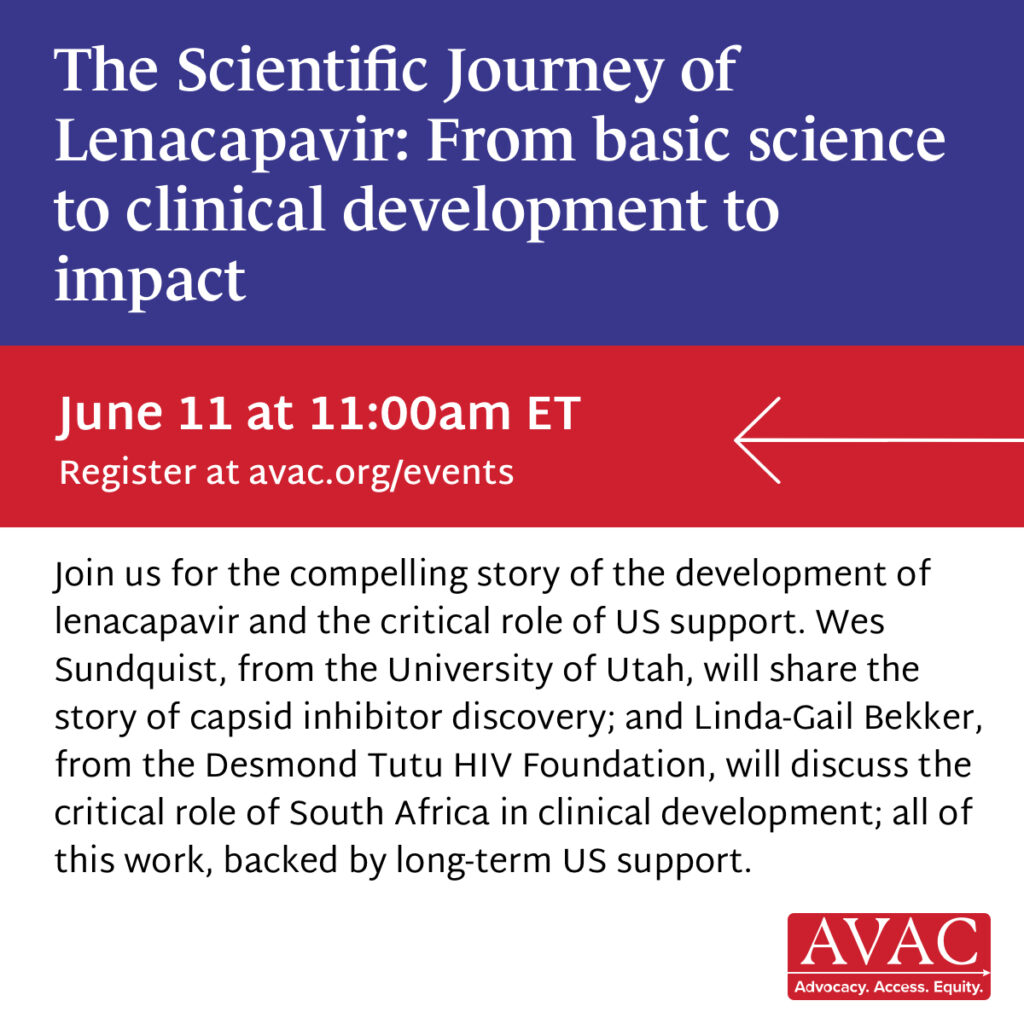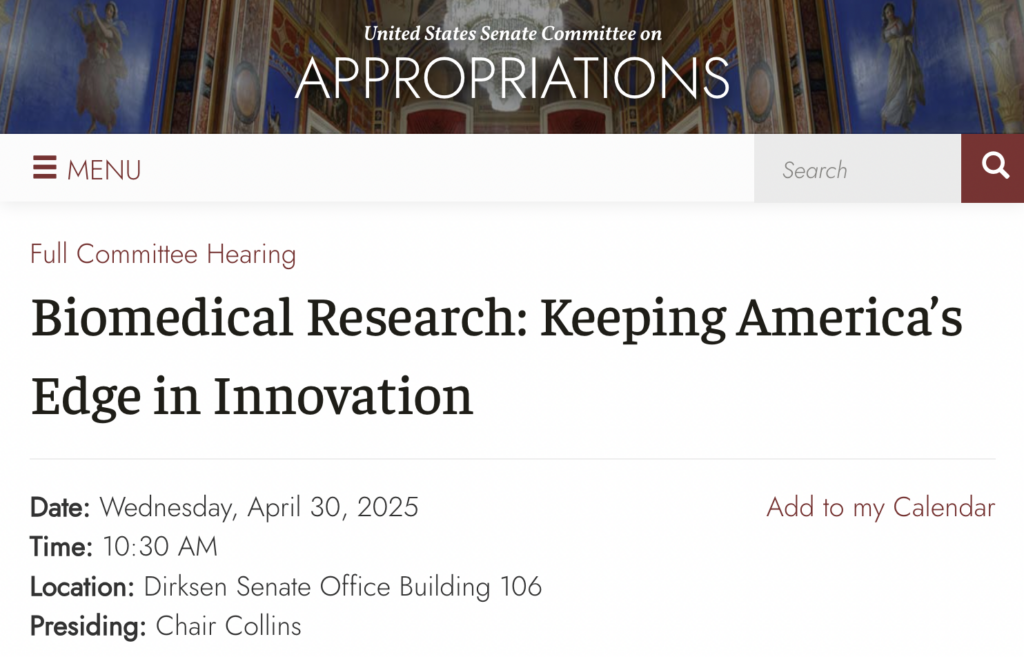This week’s issue covers the Secretary of Health and Human Services’ defense of deep NIH budget cuts before Congress, leadership changes at WHO, and the latest update in AVAC’s lawsuit attempting to halt the US foreign aid freeze.
Importantly, this issue also includes new resources and analysis about the impact of the US administration’s short-sighted cuts on biomedical research. We at AVAC just launched a new report, HIV Prevention R&D at Risk: Tracking the Impact of US Funding Cuts, which puts the impact of the US government’s dismantling of HIV research and global health infrastructure into urgent context. And our colleagues at the Treatment Action Group (TAG), Médecins Sans Frontières (MSF), and the South African Medical Research Council (SAMRC) launched a new report detailing the specific impacts of funding withdrawal on HIV and TB research in South Africa.
As HIV Vaccine Awareness Day approaches this Sunday, May 18, we spotlight what’s at stake as the entire HIV response—from basic discovery, to clinical research, to access, and equity—is under attack. Read on for more.
HHS Secretary Defends Proposed FY26 Budget in Front of US House and Senate
On Wednesday, Secretary of Health and Human Services Robert F. Kennedy Jr. testified before the House Appropriations Subcommittee on Labor, Health and Human Services, Education, and Related Agencies and the Senate Committee on Health, Education, Labor and Pensions (HELP) to try and defend the US administration’s proposed Fiscal Year 2026 (FY26) budget. The proposed budget calls for a nearly $18 billion cut to the National Institutes of Health (NIH). In response to questioning, Kennedy repeatedly cited the need to reduce “waste” and redirect funds toward chronic disease prevention and domestic health programs. He continually denied that the cuts to the workforce and funding have harmed ongoing clinical trials and falsely claimed that research grant terminations have resulted in no scientists losing their jobs. He signaled support for biomedical research only if it aligns with “Gold Standard science” and US national security interests.
In advance of the meetings, US Senator Bernie Sanders (D), released a report documenting “Trump’s War on Science”. See AVAC’s new resource hub Research Matters: Resources to Protect Research Funding, co-created with TAG and the HIV Medicine Association (HIVMA), to support researchers advocating for sustained NIH funding and see the letter AVAC and more than a dozen partners submitted to the Senate HELP Committee urging lawmakers to reject the cuts to NIH funding for HIV, TB, and STI research and highlighting the impact of these cuts on lifesaving innovation and research infrastructure.
IMPLICATIONS: Kennedy’s testimony confirmed the administration’s intent to permanently reshape the federal public health infrastructure. If the proposed budget is enacted, these changes could devastate HIV prevention research, halt progress on new tools like injectable PrEP, and silence inclusive science.
READ: RFK Jr. Acknowledges Proposed NIH Cuts Will ‘Hurt’—Newsweek
WHO Restructures
The World Health Organization (WHO) announced major cuts to its headquarters and the departures of long-time leaders in response to the $1.7billion shortfall and pressure to decentralize operations. Jeremy Farrar, former head of the Wellcome Trust and current WHO Chief Scientist, will lead the largest division on Health Promotion, Disease Prevention and Control — one of the four new divisions in the organization. Sylvie Briand will replace Farrar as the new Chief Scientist. Up to 40% of headquarters staff may be laid off and its 10 divisions will be consolidated into four.
Meanwhile, UNAIDS pushed back against merger proposals and plans under WHO’s UN80 initiative Task Force, which is tasked with reforming the UN system.
IMPLICATIONS: With WHO seeking to relocate critical infectious disease programs to the Global South, these changes could open space for more regionally driven research agendas. The changes also offer a chance to refocus country-led responses.
READ:
- BREAKING – WHO Director General Shakes Up Agency with Brand New Leadership Team—Health Policy Watch
- WHO’s Samira Asma Reportedly Leaving Tedros’ Leadership Team – UNAIDS Scraps Merger Plan—Health Policy Watch
Judge Denies USG’s Request to Restart Foreign Aid Freeze and Orders All Payments to Resume
In the ongoing AVAC vs. Department of State and Global Health Council vs. Trump lawsuits, the federal District Court denied a motion by the government for an indicative ruling regarding the preliminary injunction that is being reviewed on appeal by the US Court of Appeals for the DC District. Last month, the government asked the court to revisit its earlier ruling, citing a new Supreme Court decision, but this week, the judge rejected the motion, reaffirming that the freeze violated the law. The court also lifted a temporary pause it had placed on processing funds for non-plaintiff organizations, which means the government must now fully comply with the injunction and resume payments to all affected programs for work completed prior to February 13.
What We’re Reading
- Scientists go silent as funding cuts escalate—Science
- ‘What do we do with uncertainty?’ A former CDC director’s advice to new physicians and scientists—STAT
- US funding cuts have crippled our HIV work – what’s being lost—The Conversation
- Scientists Hail This Medical Breakthrough. A Political Storm Could Cripple It—The New York Times
- What is Trump’s ‘most favored nation’ drug pricing policy and how will it reduce costs? Explained—The Economist
- Q&A: HIV shot ‘must reach all who ask for it’—SciDevNet
- Institutionalizing politicized science—Science
- WHO and Medicines Patent Pool announce sublicensing agreement for rapid diagnostic test technology—WHO
- Breaking: RFK Jr. says Matthew Buzzelli, a lawyer with no public health experience, is the Acting CDC Director—Inside Medicine
- Why the 1 senator who can rein in RFK Jr. isn’t calling him out—Politico
- HIV RNA Testing Appears Unnecessary for Patients Taking Oral PrEP—TheBodyPro
Resources
- U.S. Funding Cuts Threaten 39 Research Sites in South Africa Putting Scientific Advancements and Hard Won Progress Against TB and HIV at Risk—TAG and MSF
- HIV Prevention R&D at Risk—AVAC
- Advocates’ Guide: Understanding the President’s Proposed Fiscal Year 2026 (FY26) Budget and Its Implications for Science, Research and Global Health—AVAC
- Worldwide Prevention, Shared Protection: Why STI Funding Matters—AVAC
- Critical Advocacy: How Civil Society is defending the HIV Response and Global Health—AVAC
- Research Matters—AVAC, HIVMA, TAG
- Impact of NIH Grant Terminations—Association of American Medical Colleges
Save the Date!





